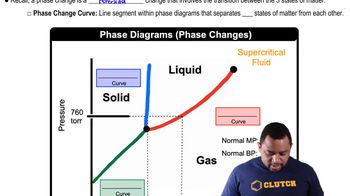Here are the essential concepts you must grasp in order to answer the question correctly.
Phase Diagram
A phase diagram is a graphical representation that shows the phases of a substance as a function of temperature and pressure. It delineates the boundaries between different phases, such as solid, liquid, and gas, and indicates the conditions under which these phases exist. In the context of liquid crystals, the diagram also includes regions for smectic, nematic, and isotropic phases, which are crucial for understanding phase transitions.
Recommended video:
Phase Changes in Diagrams
Liquid Crystalline Phases
Liquid crystals are materials that exhibit properties between those of conventional liquids and solid crystals. The smectic and nematic phases are two types of liquid crystalline states. In the smectic phase, molecules are organized in layers, while in the nematic phase, they are aligned but not layered. Understanding these phases is essential for predicting how molecular ordering changes during phase transitions.
Recommended video:
Crystalline Solids Structure
Phase Transition
A phase transition refers to the transformation of a substance from one phase to another, such as from solid to liquid or from liquid to gas. In the context of the question, as the temperature increases at a constant pressure, the substance may transition from a smectic or nematic phase to an isotropic phase. This transition involves a change in molecular ordering, where the structured arrangement of molecules in the smectic or nematic phase becomes more random in the isotropic phase.
Recommended video:
Phase Changes in Diagrams




